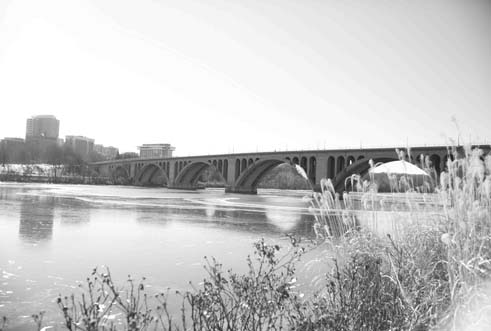Key Bridge Rehab Slated to Begin in May

By Brady HoltCurrent Staff Writer
The D.C. Department of Transportation will kick off a two-year project to rehabilitate the Key Bridge this spring, but it is promising relatively limited traffic disruptions.
The 1925 bridge, which runs between Georgetown and Rosslyn, Va., saw its last major work in 1986, the Transportation Department’s Rick Kenney said at last week’s Georgetown advisory neighborhood commission meeting.
Unlike with the bridge’s 1986 overhaul, motorists shouldn’t expect major traffic disruptions this time. The bulk of the project affects the substructure, with workers accessing the underside of the bridge from a barge, according to Kenney.
“It’s a concrete structure — most of the work is addressing deteriorating concrete,” he said. “You won’t see the workers. They’ll be under the bridge, in the arches, under the deck.”
Other project work includes replacing the streetlights with new LEDs, installing a warning signal to alert drivers when pedestrians and cyclists seek to cross the Whitehurst Freeway exit, repainting the ornamental fence, and strengthening the barrier between cars and the sidewalk.
Those changes will require the closure of each sidewalk on the bridge for 90 days (at different times). There will also be single-lane closures throughout the project’s duration, occurring only in “off-peak times” outside of rush hour, which Kenney said should have “very limited impacts.” The project is slated to last from May 2015 through May 2017, and to cost between $15 million and $30 million.
Kenney emphasized that despite complaints about the Key Bridge’s complex intersection with M Street, this work covers only preservation and restoration of the bridge structure: “It’s not a traffic signal project — it’s strictly bridge funds for bridge rehab.”
Neighborhood commissioners raised some concerns about the project. With traffic, they warned that Georgetown attracts visitors at many times outside the normal rush hour. “On weekends, especially during the warmer weather, which is when you guys are starting, it’s not ‘off-peak’ here starting at noontimes,” said commissioner Bill Starrels.
Starrels also asked the Transportation Department to provide traffic control officers at busy times when the sidewalk is closed, to help pedestrians cross the street at the M Street intersection. Kenney said that might be difficult because the officers are assigned to permanent locations, but some other type of help might be available.
Commission chair Ron Lewis also raised concerns about the plans for LED lights. “Pay close attention to the light color value,” he told Kenney.
“It will be that bright white,” replied Kenney. “It’s not mercury vapor — it will have a different character to it.”
Lewis said the Transportation Department should consider Georgetown’s federally protected historic status and submit its proposals to the Old Georgetown Board, part of the U.S. Commission of Fine Arts.
According to Lewis, the board should be consulted “on anything that changes the current visual appearance including lighting, because that is a very visible, iconic bridge and at night the lighting is basically what you see.”
Commissioners also requested a private meeting with the agency to discuss noise impacts from night work.
This article appears in the Jan. 14 issue of The Georgetown Current newspaper.





